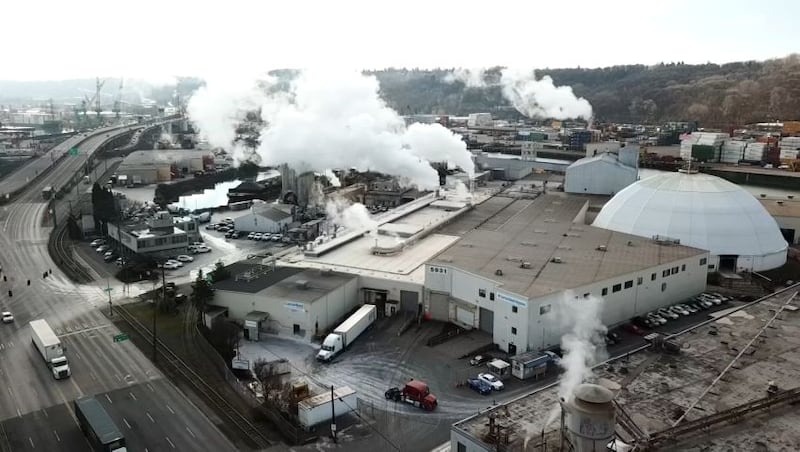SEATTLE — You likely don’t think about the air you breathe on a regular basis – maybe your lungs burn for extra air on a jog, or during wildfire season you consider wearing a mask – but few among us are thinking about the air we breathe on a regular basis.
The people of Duwamish Valley may be an exception to that rule. The neighborhood, a largely BIPOC community, is the type of place you can’t help but think about the air you breathe. As Paulina Lopez, the executive director of Duwamish River Cleanup Coalition (DRCC), explains the youth her team works with are all too familiar with concerns over air quality.
“When we say, ‘Raise your hand if you have asthma,’ a majority of them raise their hand,” said Lopez. “Some say, ‘I thought asthma was normal because everyone has it.’”
Lopez is among the more vocal voices about the current plight of the Duwamish Valley. It’s an area familiar with the fallout from pollution.
If you walk along the final few miles of the Duwamish River you’ll spot warning signs about not eating the fish. The water has garnered a lion’s share of attention ever since the U.S. Environmental Protection Agency (EPA) declared the final few miles of the river a Superfund Site – basically it means the land is among the nation’s most toxic sites, and it’s been identified to be cleaned up.
The water, however, isn’t the only concern. Air quality has been a focus for some time due to the higher than normal asthma rates found in the region, but since the closure of the West Seattle Bridge the amount of traffic on residential streets has increased. The recent closure of the First Avenue Bridge only added to the amount of traffic.
Chief concerns in South Park and Georgetown include diesel emissions, toxic releases from industry and particulate matter. In fact, when the state launched it’s “environmental health disparity map” in 2018, it listed each of those environmental exposures at the highest level in the area encompassing the Duwamish Valley; other studies have indicated living in the Duwamish Valley will drop your life expectancy by years, something not solely attributed to air quality.
“It’s everything cumulatively that impacts communities like ours that are already vulnerable in terms of our health,” explained Lopez.
It’s hard to tell whether people who don’t live, or frequent, the area truly understand the burden shouldered by the people who live in the Duwamish Valley. Encouraging regional headlines have a way of muting local concerns. Troy Abel, a professor of environmental policy at Western Washington, who serves as a technical advisor to the DRCC, noted a 2020 EPA release with a headline reading: “EPA reports overall 12 percent decline in industrial toxic releases for the Pacific Northwest, Idaho and Alaska.”
“This is a common problem in geographic science,” said Abel. “When you change the scale, all the statistics change.”
The report does note that most of the decrease is attributed to changes in metal mining in Alaska. Abel looking at the air release portion of the report noted that 2019 – the most recent year with available data in this report – was among the worst years in terms of toxic air releases.
Abel has also raised concerns about whether we get an accurate picture of what people breathe in on a day-to-day basis. Speaking with KIRO 7, Abel pointed to a 2018 barge fire that left smoke billowing into the air for hours with toxic materials burning – the air quality index for that day measured good air quality.
According to the EPA, emergency monitoring can be brought in for such instances as a safety precaution, but the typical air monitoring system doesn’t run 24/7. Instead, it takes measurements at various times throughout the week at multiple locations.
The bottom line: capturing all areas, at all times, is an expensive proposition. In Puget Sound, the amount of monitoring exceeds the minimum requirements laid out by the federal government, though some would like to see both the amount of monitoring and the levels of pollution allowed changed.
“Science is telling us these standards aren’t good enough,” said Abel.
There is some added attention coming to the area, in large part, because of the DRCC’s work. The group’s Duwamish Valley Youth Corps launched a study of moss in Seattle’s South Park and Georgetown neighborhoods. The samples they collected were analyzed and found high levels of metal.
“Some of our recent research shows that we’re missing a toxic metal hot spot, right up the river from us here,” said Abel. “And it could be coming from a source is not regulated under any air regulation right now.”
The study was spotlighted by the National Institute of Environmental Health Sciences, and the EPA has given a grant to the Puget Sound Clean Air Agency to fund additional monitoring in the area. The process of determining where/how air will be measured is now underway.
“I look at the eyes of our youth that we work with every week,” said Lopez. “I look at the eyes of my kids. I really am not going to give up until I know they can breathe better air and have access to all the opportunities other youths and other neighborhoods have given to them.”
That work continues at the DRCC which always works to draw attention to the day-to-day issues their community faces, while pushing for changes to the standards in what’s allowed in terms of air pollution.
Cox Media Group








